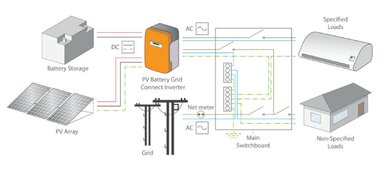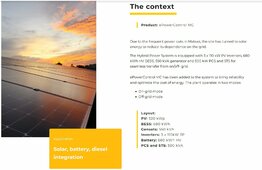You are using an out of date browser. It may not display this or other websites correctly.
You should upgrade or use an alternative browser.
You should upgrade or use an alternative browser.
Grid Forming Inverters
- Thread starter magnet creek
- Start date
Ampster
Renewable Energy Hobbyist
The strategy to make a grid tied inverter work when the grid is out is to have a grid forming inverter which can AC couple to the grid tie inverter when the grid is out. Each inverter has different requirements in terms of the size of the grid tied system and the size of the battery in the grid forming inverter. Also to work most effectively the specs of the grid tie inverter must confirm to the latest UL1741.As mentioned earlier, the inverters do all the necessary control and sensing of frequency voltage and other factors to confirm a simulated grid exists.What's your control strategy when you face with grid outage?
Last edited:
But they can not flow the power and manage the whole energy in micro-grid. So I guess, besides the inverters (battery/PV inverters), we need centralized controller to control and manage the energy in micro-grid.The strategy to make a grid tied inverter work when the grid is out is to have a grid forming inverter which can AC couple to the grid tie inverter when the grid is out. Each inverter has different requirements in terms of the size of the grid tied system and the size of the battery in the grid forming inverter. Also to work most effectively the specs of the grid tie inverter must confirm to the latest UL1741.As mentioned earlier, the inverters do all the necessary control and sensing of frequency voltage and other factors to confirm a simulated grid exists.
Ampster
Renewable Energy Hobbyist
I do not know what kind of micrigrid you are contemplating but the power flows from the inverter to the devices drawing current. It is simple physics. The inverter produces enough power to supply those loads.But they can not flow the power and manage the whole energy in micro-grid. So I guess, besides the inverters (battery/PV inverters), we need centralized controller to control and manage the energy in micro-grid.
So you are talking about this kind of inverter. Right?I do not know what kind of micrigrid you are contemplating but the power flows from the inverter to the devices drawing current. It is simple physics. The inverter produces enough power to supply those loads.
Assume we have diesel generator for back up during outage. How can we control voltage and frequency or power of microgrid?

Could you please introduce a multi-mode inverter in real application? I'd like to check its datasheet.Most hybrid inverter do.
- Pass-through relay open, grid forming.
- Pass-through relay closed, grid following.
Closing pass-through relay is based on first detecting AC voltage present on AC input then aligning inverter's voltage/freq/phase (becoming a slave) before closing pass-through relay.
Some newer systems place the grid disconnect relay external from hybrid inverter, between utility input lines and main panel and allow multiple hybrid inverters and/or PV GT inverters to provide AC feed power directly to main panel. Again, pass-through relay open means grid forming, with one of the units feeding panel being reference master.
Providing power contribution does not mean a source is phase master, although it can help lower micro-grid mastering impedance.
Thanks!
Ampster
Renewable Energy Hobbyist
I was responding to your post. This thread is about grid forming inverters which operate within narrow voltage and frequency specifications depending on which country they operate in. The user typically has no control over those parameters. That picture is showing what I would describe as a hybrid inverter installation which may have grid forming and grid following capabilities. There are several brands mentioned in this and other threads. Try a Google search for "hybrid inverter"?So you are talking about this kind of inverter. Right?
Last edited:
If we have a diesel generator in this architecture, It should be connected directly to AC bus, or do we need converter/inverter as an interface?My another question is control of microgrid. If these inverters can control the voltage and frequency, why do we need to add another controller for microgrid? The figure below shows a separate controller in addition to the inverters.
View attachment 210244
Few post earlier, some guys said, inverters convert DC to AC or vice versa, but Gen is produced AC voltage and connected to AC bus.You have to have something to control the generator, if the inverter you choose can control a generator then you use that, if not then you need to add another controller which adds complication.
So can we use inverter for it?
Yes, very sophisticated for its age, modern versions of the SI and alternatives work better feature wise but the old ones are built to last and do.Is Sunny Island bidirectional inverter?
It seems this inverter uses internal grid-forming method to control the voltage and frequency, and all energy resources follow the voltage/frequency produced by inverter. Am I correct?Yes, very sophisticated for its age, modern versions of the SI and alternatives work better feature wise but the old ones are built to last and do.
Another scenario is during off-grid situation, this inverter get a voltage/frequency sample of one of the units (like generator or battery) and the rest of units follow the voltage and frequency (grid-following).
Which one is rational for this inverter?
OK there's a danger here that you're skirting with.Another scenario is during off-grid situation, this inverter get a voltage/frequency sample of one of the units (like generator or battery) and the rest of units follow the voltage and frequency (grid-following).
It is possible to AC-couple some solar systems, where everything inside the house connects to one AC bus. The main inverter supplies the AC power and the smaller microinverters (on the panels themselves) connect to that AC power and dump their power into it. The inverter must be designed for this, and the design/microinverters must be chosen so that they play well together. An example is frequency power control, where the inverter increases the frequency if the batteries are almost fully charged, so the microinverters know to back off.
The danger is that someone can hear that and think "great idea! I can get a small/cheap inverter and 'fool' my microinverters into turning on! I'll get free power during the day with almost no $$$." This does not work, since small/cheap inverters cannot handle the output of all those microinverters.
Another danger is that you try this with a generator, which cannot handle such inputs. Several people have destroyed their generators this way,
Yes, but it fails as soon as one generator does not respond to the frequency shift, I have yet to see any micro inverters that respond to frequency shift.It seems this inverter uses internal grid-forming method to control the voltage and frequency, and all energy resources follow the voltage/frequency produced by inverter. Am I correct?
What's your suggested architecture?OK there's a danger here that you're skirting with.
It is possible to AC-couple some solar systems, where everything inside the house connects to one AC bus. The main inverter supplies the AC power and the smaller microinverters (on the panels themselves) connect to that AC power and dump their power into it. The inverter must be designed for this, and the design/microinverters must be chosen so that they play well together. An example is frequency power control, where the inverter increases the frequency if the batteries are almost fully charged, so the microinverters know to back off.
The danger is that someone can hear that and think "great idea! I can get a small/cheap inverter and 'fool' my microinverters into turning on! I'll get free power during the day with almost no $$$." This does not work, since small/cheap inverters cannot handle the output of all those microinverters.
Another danger is that you try this with a generator, which cannot handle such inputs. Several people have destroyed their generators this way,
My microgrid consists of BESS, PV, generator, and AC load. The situation is off-grid.
Yes, but it fails as soon as one generator does not respond to the frequency shift, I have yet to see any micro inverters that respond to frequency shift.
Do you mean BESS should be a grid-forming unit and the rest of the units should be grid-following?Yes, but it fails as soon as one generator does not respond to the frequency shift, I have yet to see any micro inverters that respond to frequency shift.
Similar threads
- Replies
- 2
- Views
- 170
- Replies
- 2
- Views
- 194
- Replies
- 14
- Views
- 617
- Replies
- 1
- Views
- 273




